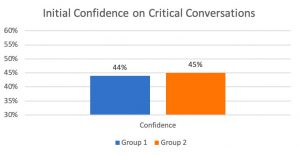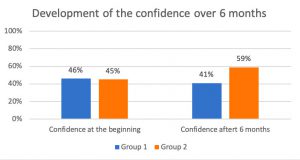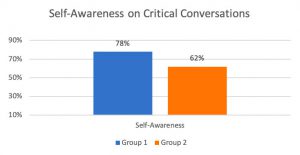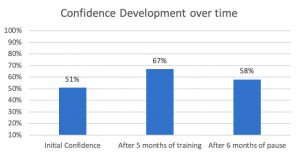
Unless the Leaders inside your organization live in a vacuum, they need to communicate with their employees. At all levels, on many subjects and for several reasons. Every day.
Making decisions implies communicating and sharing those decisions. Leading by example means being an example of clear, transparent and effective communication. Managing a team requires settling disputes, encouraging, motivating and listening to all members.
It’s a busy job, and delicate too.
Of course, conversations are the conduit for communication. Communication as a Leader is a specific genre that is often one-to-one in emotionally-charged situations. The route to the finish line is often through uncharted territory without clear guidelines.
That’s why we commonly refer to those situations as “critical” or “crucial” conversations, referring to the fact that they are definitely not easy to manage.
We believe that is one of the reasons why so many Leaders fail in conducting successful conversations. Leaders often start off the wrong way because they consider these conversations to be difficult, which too often leads to a self-fulfilling prophecy.
What follows is quite easy to imagine: we tend to avoid as much as possible those conversations, which results in an ever-shrinking comfort zone to the point where we consider those moments as really uncomfortable.
This spirals into impacting our self-awareness about how we can actually perform in those situations.
Unless the Leaders inside your organization live in a vacuum, they need to communicate with their employees. At all levels, on many subjects and for several reasons. Every day.
Keep the focus on what really matters
When you consider that conversations are the moment when potential turns into collective energy, the 20% factor of a Leader that makes the 80% of the difference in team results, the question becomes: how can we work out a better way to deal with conversations?

Here at SkillGym, we call it the C-Factor. The specific skill and attitude that high-performing Leaders show when involved with Critical Conversations by turning these conversations into genuine empowering moments.
How do they do it? Is there a secret to be unveiled?
Is there a way to scale up their level, their attitude, and their skills so that everyone in the organization can contribute to generating energy through empowering conversations?
Over the years, we met many organizations and, within them, innumerable Leaders and their employees. Our research conducted while developing the SkillGym methodology led us to the following encouraging conclusions:
- It’s more or less the same everywhere: humans tend to stay in their comfort zone and confrontation is typically perceived as outside that zone
- In contrast, employees almost always claim that they would prefer to have more frequent, transparent conversations with their bosses rather than less
- More importantly, many employees recognize “leadership” in the conversation moments, when they get motivated and driven
- The best performing Leaders are almost always also those who strive to excel in transparency and commitment to communication with their employees
- We met very few Leaders who were just “naturally” gifted with the ability to manage Critical Conversations; the vast majority struggle with their own instinct to avoid confrontation but try to do better and better every day in this field
This last point is particularly interesting because there really is no secret formula to excel in conversations. Those who succeed achieve their results pushing forward every day.
We met very few Leaders who were just “naturally” gifted with the ability to manage Critical Conversations; the vast majority struggle with their own instinct to avoid confrontation but try to do better and better every day in this field.
Practice, practice, practice
Of course there are some best practices to follow (several interesting books are available on the subject, look here if you are interested) and certainly taking a course on communication skills makes sense, especially at the beginning of one’s career, to help focus one’s own efforts.
But in the end, it’s mostly about practice. The more you practice, the more you gain confidence and raise your self-awareness.
Your comfort zone starts to expand as soon as you move the first step toward trying and trying again.
That’s the point. Talent is overrated and fear of confrontation has to be fought by practicing.
It’s not as easy as it sounds, of course, but it’s worth it given the impact a great conversation can have on the employees’ and team’s energy.
We have studied hundreds of Leaders who made their way through this challenge to see what they would consider the enabling factors that they consistently worked on to improve their conversation skills.
Over time, we have identified four recurring ingredients that can help increase a Leader’s C-Factor (by the way, “C” can represent so much: Communication, Conversation, Courage, Confidence, Continuity of practice, etc.)
One of the reasons so many Leaders fail in conducting successful conversations: they start the wrong way since the beginning, considering those conversation as difficult. This too often leads to a self-fulfilling prophecy.
1. Try. It seems obvious, but most of the times what holds us back from succeeding is just the fact that we are scared about the (potentially negative?) outcome.
This ingredient does not apply only to Critical Conversations in business, of course.
But it’s worth a reminder here that the first step we should always take to start is…a first step. In practice. Nothing to add here.
2. Have a work-out plan. Trying alone won’t take you far. To improve, you need to get organized. This point can be developed in several ways, but in short:
a. Identify the conversations that matter most. You can’t be great in all disciplines. At least at the beginning, so focus is paramount. Also, don’t forget the golden 80/20 rule: 20% of the conversations (types of conversations, by the way) make 80% of the impact. Focus on a few, key types of conversation and work your way toward mastery.
b. Identify at least two key metrics upon which you want to improve. All the best performing Leaders we spoke with agreed that it’s much harder to improve something that you do not measure. Again, there are a lot of possible metrics, maybe too many. The two most efficient items to measure, in our experience, are: confidence and self-awareness. They are easy to measure but very powerful in a development path. See below some more details about the two skills.
c. Seek for unbiased feedback. Nothing accelerates improvements as much as receiving feedback. Unfortunately, it’s not easy. Again, humans are poor at providing feedback (since we don’t like too much exposure) and even poorer at seeking feedback. But it’s the one single factor of a practice program that provides the highest impact.
d. Schedule conversations in advance and do it consistently. We are hard-wired with our calendar. Whatever goes in the calendar normally gets done. Push yourself to schedule even the most uncomfortable conversations. It won’t be easy in the beginning, but you’ll get used to it soon.
3. Look for help. Executive coaching is an excellent way to support conversational skills. Role Plays are a great learning strategy. Peers can help too (reciprocally).
The emerging world of Digital Role Plays is one of the best allies you can rely on (SkillGym is a great example, but look at this article “Digital Role Plays, the Best Way to Develop Conversational Leadership” if you want to learn more about Digital Role Plays as a category of digital learning tools).
4. Don’t settle. Apart from riding a bicycle, all other skills require maintenance. The one thing you should not do is to assume you are done at a certain point.
You are never really done. There is always room for improvement and acquired skills require maintenance to keep them active. So, keep on practicing, whatever happens.
Apart from riding a bicycle, all other skills require maintenance. The one thing you should not do: think that at one certain point it’s done. It’s never really done.
Proof is in numbers
For years, we’ve been proving the reasoning for this list. Every day, we continue to witness that this list does not change. Leaders come and go, but these principles never go out of style. It’s always about struggling against the instinct to fear confrontation, whilst practicing to improve and measure change.
We have built our SkillGym methodologies following these principles and we have helped hundreds of thousands of Leaders around the world to ease their practice schedule on Critical Conversations.
We have extensive data supporting these principles and we review these data regularly to extract new evidence. Let’s go over this data together.
(All of the following data comes from our routinely updated database listing over 250k users, with 10k+ simulated interviews played every day).
The first interesting fact: the two groups are made up of Leaders with similar age and seniority cohorts.
Group 1 went through an intensive “traditional” course on leadership communication skills just before entering SkillGym. Group 2 just entered SkillGym with no specific courses completed in the prior 12 months.
The graphic below shows the Confidence (*) as recorded during their first simulated interview, which was comparable for both groups.

Of course, this does not mean that traditional courses are not useful, however, look at the next graph:

Here we have compared again two different groups (same age, same seniority).
Both completed an assessment on a Critical Conversation in SkillGym. Then Group 1 did not participate in any practice, whereas Group 2 attended a Digital Fitness program on SkillGym for around 6 months. Then we asked Group 1 to take the test again.
See the point? Clearly, practicing goes a long way and almost always overcomes raw knowledge.
(*)We define “Confidence” as the skill of feeling comfortable with a situation, in this case, a Critical Conversation. In more technical terms, Confidence measures Leader’s capability in managing the conversation to make the best of it in terms of matching its core objectives.
Let’s dig deeper.
We have compared the Self-Awareness (*) dynamics of two groups of Leaders simulating several types of Critical Conversations.

Interestingly, the youngest (or “less experienced”?!?) Group 1 scored consistently higher than their “experienced” and certainly more senior peers in Group 2.
Does it ring a bell? We hear all the time things like “Training is not for me, I have my way, I know what to do” from part of the senior management.
(*) We measure Self-Awareness as the gap between the evaluation of the performance in the conversation provided by SkillGym and the self-evaluation collected from the Leader at the end of the conversation. The larger the gap, the lower the Self-Awareness.
As we continue, you can see in this graph what happens when Leaders practice consistently on Critical Conversations, but then stop.

You can change the world
What does all this mean? To me, it clearly shows that:
- Practicing is much more important than just storing knowledge
- Seniority does not necessarily mean better performance in communication
- Communication skills need to be maintained over time with consistent training
- A great training tool can make a big difference
- When conversations work well, the team works well, performance increases and everyone is happier
- Leaders can really change the world by developing their C-Factor
Now, let’s draw some conclusions from all of this. The recipe for developing the C-Factor looks clear. But how can you, as an HR and L&D professional help your Leaders to go this route?
In my experience, those who really implemented a sustainable and effective long-term strategy for supporting the C-Factor went through three steps:
1. Rebalance their programs, by placing more importance on practicing than on knowledge storage. Knowledge is everywhere nowadays and Leaders hate being flooded with information. Let them practice, let them make mistakes in a safe environment.
2. Think long-term. Reduce the “pit-stop” approach (2-day courses, twice per year and then go and perform) and replace it with a consistent program of continuous practical exercises. It can be delivered in any form, but please start considering skill development as a sport. Would you imagine Roger Federer going to a class a couple of days every now and then and nothing else? How could he possibly compete with the champions?
3. Consider technology. Conversation is a role play. No doubt about that. That’s why role playing is the most suitable learning strategy to practice conversations. Digital Role Play can let you scale (which is what you need if you want to plan long-term) both on numbers (of Leaders you can involve) and consistency over time.
At this point, you may want to delve deeper into the subject of Digital Role Plays and the benefits that you can derive from a solution like this.
Here you can find an article (“Digital Role Plays, the Best Way to Develop Conversational Leadership”) describing in detail what Digital Role Plays are, how they work and what you can achieve with this type of solution.
Here you can watch some interesting webinars just released showing interesting case histories of what happens when you blend Digital Role Plays into your learning strategy.
Thanks for reading!
Feel free to comment below or book a 1-hour discovery call of SkillGym.

